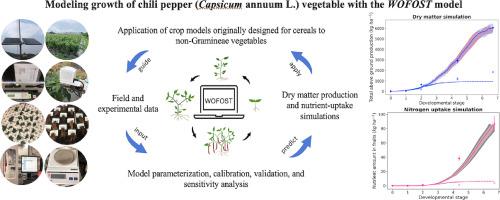Agricultural Systems ( IF 6.6 ) Pub Date : 2023-05-26 , DOI: 10.1016/j.agsy.2023.103688 Ruoling Tang , Iwan Supit , Ronald Hutjes , Fen Zhang , Xiaozhong Wang , Xuanjing Chen , Fusuo Zhang , Xinping Chen

|
CONTEXT
Chili pepper (Capsicum annuum L.) is one of the most economically and agriculturally important, and relatively nutrient-dense, vegetables that has, to date, received little attention in model studies relevant to dry matter production and nutrient-uptake predictions. There is an urgent need for models to analyse the potential impacts of climate change, as well as responsive adaptation options, while simultaneously optimising productivity against fertilizer use to reduce nutrient pollution.
OBJECTIVE
We adapted the WOrld FOod STudies (WOFOST) crop growth simulation model for chili pepper (WOFOST-Chili) to quantify dry matter production as a function of fertilizer management, climate, and soil conditions.
METHODS
We used 2021 field trial data under optimal growing conditions in southwestern China to parameterise and calibrate WOFOST-Chili. The model was tested under no-fertilizer conditions and further validated with data from 2019 and 2020. In addition, a sensitivity analysis over the three consecutive years was performed.
RESULTS AND CONCLUSIONS
Overall, the developed WOFOST-Chili model shows good simulations of chili growth dynamics in response to nitrogen (N) fertilization, both on biomass assimilation (rRMSE = 0.07 for total aboveground production; rRMSE = 0.06 for fruit dry weight) and nutrient uptake (rRMSE = 0.46 for leaf N amount; rRMSE = 0.29 for fruit N amount). Additionally, model robustness is increased by the sensitivity analysis of crop initialisation (e.g., biomass and leaf area index at transplanting) and climate-dependent parameters (e.g., temperature sums determining development rate and light use efficiency determining productivity), with the resulting wider simulation range covering more observations. This good performance is only limited by a weaker leaf area index (LAI) simulation (rRMSE = 0.76), which is partially attributed measurement limitations (e.g., equipment, weather conditions and labour/time constraints). Model validation confirms good performance under potential conditions, which is slightly reduced under nutrient-limited conditions.
SIGNIFICANCE
These findings improve our understanding of yield-nutrient interactions of chili pepper. They provide insight on expanding the application of crop models originally designed for cereals to non-Gramineae vegetables, while calling for future improvement of model accuracy under different fertilizer application strategies.



























 京公网安备 11010802027423号
京公网安备 11010802027423号